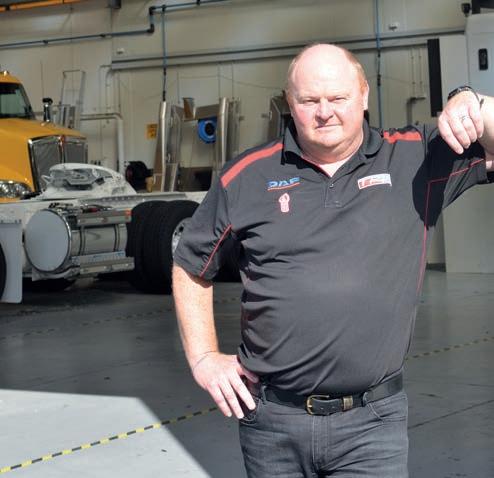
26 minute read
Southpac Trucks Legends
Dream maker
- Aaron Headington
WITH A CAREER THAT’S (SO FAR) SPANNED THREE
decades, Aaron Headington has moved from being a handson engineer to creating a specialised division of Southpac Trucks that could be best described as ‘bringing customers dreams to life’. He’s got an eye for detail and a passion for detailing and it’s for this reason he’s a Southpac Truck Legend.
Born in Auckland but travelled extensively due to his father being in the Army, Aaron left school looking for an apprenticeship in cars but to no avail.
“To be honest, I wasn’t into trucks, for as long as I can remember I wanted to be a car mechanic. I couldn’t get a car apprenticeship anywhere, so off a whim, I called in here [when it was Specialist Transport Equipment] and asked the Service Manager if they were looking for any apprentices and it turned out that they were. That’s how it all started.”
Aaron began work as an apprentice truck mechanic in February 1990 and then in July STE changed to South Pacific Trucks and became Kenworth and Foden distributors. Aaron says “I was there until late 1993 and that’s when Carter-Holt wanted to get out of trucks and we all got made redundant.”
For a short break, he took a role at Nissan Diesel, then when newly formed Southpac started up in January 1994, Mike Carliss and Maarten Durent asked me if I’d come back (did he actually leave?) “I started in February and haven’t looked back since.”
Aaron says that he never really gave his car apprenticeship dream a second thought after that, “because I found trucks a lot more interesting than cars. Everything was the same, engines, transmissions, diffs all that stuff but a lot bigger and I really liked the whole truck aspect, everything is urgent.”
Aaron preferred the engineering side of the work, the fitting and the welding but as the ‘noughties’ came around, Aaron ‘reluctantly’ moved into the office.
“About the year 2000, the service writer/receptionist left and Dave Tennant the service manager said ‘why don’t I apply for the position?’ I said why me? Why would I want to be a service receptionist?”
Apparently Dave explained that the role was going to evolve and that Aaron would be ideal.
“So I came off the floor and started as a service writer and with me coming in with mechanical experience it helped to sort out a lot of operational issues.”
He says that the position evolved into the Assistant Workshop Manager’s job, which came with more challenges and responsibility including looking after the technicians.
“In 2002, the DAF Product Manager left and they asked if I wanted to apply for the role. I said “why me?” Why would I want to work in truck sales?”
Aaron recalls that Southpac was then very new to DAF. The guys really wanted to focus on after sales and provide the best technical support available, and also work with the factory to engineer the trucks for New Zealand conditions. My background was ideal for that so I said sure, why not and took on the DAF Product Manager’s job.”
With all three brands humming, Kenworth, Foden and now DAF, the expanded volume created an internal bottle neck; we needed to get smarter and more specialised in how the company got trucks on the road to our customers.
“Having come from a workshop background and now working in truck sales, I could see that there was an opportunity for the company to become more specialised and fill this gap.
Both Mike and Maarten said, “yep great,” but who do you think is going to run it? “I said” I don’t know, that’s up to you guys.”
‘It needs to be you’ came the answer and this time Aaron didn’t ask “why me?’
“I said yep, I’ll happily do it and it just happened to coincide with us moving into the McLaughlin’s Road building while we redeveloped the head office Wiri Station Road site, so everything just fell into place, it was a no brainer.”
Aaron recalls that it was a bit of a rough start. The entire truck market fell into a hole, just as we were expanding our new truck delivery capacity.
“Truck sales were just enough to keep us busy. However, we were starting fresh, no-one had done this before, this was a foreign concept to everybody and we just wrote the rules as we went. We created this whole new workshop out of nothing. Whether it is for basic compliance work and then off to a body builder, or a full truck fit-out. The whole idea was to take the customer’s request and make it reality.”
They called it ‘New Truck Preparation’ – basically every single new truck that Southpac imports and delivers comes to him. Aaron says the department kept morphing into something different and bigger.
“We expanded it further. We invested in sheet metal machinery and started doing our own in-house fabrication to improve the quality and timeframes the transport industry demands. And the

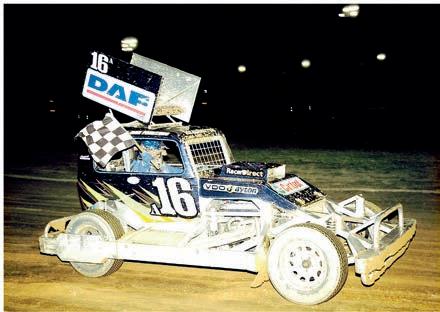
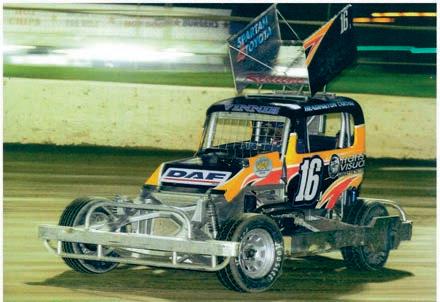
Left: After 9 years helping out in the pits Aaron decided to give Superstocks a go himself and then spent the next 15 years collecting trophy’s. Below: Times from the past.
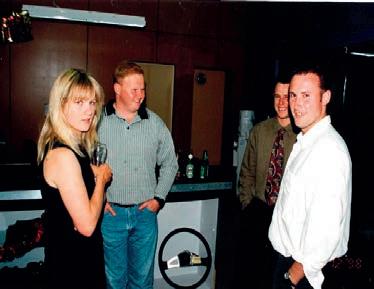
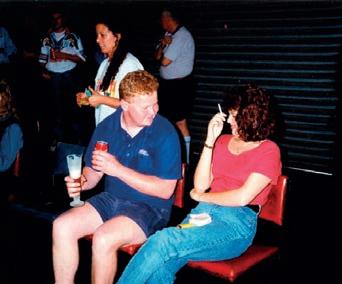
department just kept growing, to full turn key set ups, tractor units, customising exhaust air intakes, cab interiors, TV’s and whatever an owner wanted.”
Aaron says that when they started there was four of them and now they’re running at about eighteen specialist new truck technicians and still looking for more. “We’ve gone from fifty/eighty trucks a year to hundreds and we have a vision of getting even bigger than what we are today”
He says, “nowadays we know exactly what the truck means to a driver and an owner and we learnt that along the way.”
“For a lot of owner/drivers, this truck is their life. Their life savings it’s everything to them and it has to be treated as such. When we started I was really focused to change our teams mindset from working on dirty old trucks to working on brand new vehicles, the fit, finish, looking at the details. It’s an on-going thing, I ask them ‘would you accept that?’ If they say it could be better then I say make it better, because if you’re not going to accept it, why would our customers.”
He says that communication is the key to making the whole thing work.
“Trying to take what the customer has ordered with the salesman, the salesman then trying to convert that into what he thinks the customer wants and me trying to get my head around how the salesman has put it on the option sheet. Sometimes I have to go back to the customer and ask what they actually mean by this, because the last thing I want to do is build something and have the customer turn up and go ‘it’s not what I wanted’ or ‘yes that’s what I asked for but it’s not what I want.’ Neither works for me, it needs to be perfect the first time.”
He says that some customers have a specific look in mind and when we’re trying to achieve that and getting that information out of their heads can be difficult, but we always get there in the end.
“Much of what we do is aesthetic and very bespoke, but we do carry out development work too, we come up with concepts. In this age of media and social media, we see things everywhere, a lot are on Australian trucks. They send me photos and say, ‘this is what I want’ then I’ve got to copy that without copying it.”
He says that this is making the job both harder AND a whole lot more interesting.
“I enjoy the challenge of change, we don’t like doing the same thing over and over. But with change, comes time, development, investment and all that stuff.”
‘Engineer’ Aaron is very happy in his role. “I like the company and I actually enjoy getting out amongst the trucks, talking to my guys, developing new things, coming up with engineering solutions to issues with fixes, improving durability, and making everything work to suit the customer’s requirements.”
The fact that Aaron cares about the customer’s expectations that makes him so good at his job. “We make a lot of cool products, but if a customer isn’t happy with what I’ve done, I’m not happy, because then I haven’t done my job properly. I do take it very personally.”
Sure, Aaron does say he prefers trucks over cars, but when he’s not making new truck owners dreams a reality, he’s tinkering with his own ‘98 Corvette project car. This dark horse has also been a successful race driver...
“When I started here, Dave Tennant raced Superstocks and I helped him as his pit crew for about 9-years. Then I decided that I wanted to do it for myself, so I bought a car and went racing. For 15 years I raced speedway, that was a big part of my life, I got lots of trophies, too. I was the Waikato Champ and won all the points in Auckland a couple of years in a row. I could hold my own.”
Aaron turns fifty this year and thirty one years of his life has been spent at SPT (in one way or another). He says that some days, when the office work is getting too much, he misses being ‘hands on’ but says ‘I don’t think I could go back to the tools’.
So what of the future? Aaron replies “I consider this my own department, I created it, I brought it from nothing to what it is today… so for me there is no next, it’s here. It’s a great company to work for, we’re not short of work and there’s always something different to do. In other words, more dreams to be made.” T&D
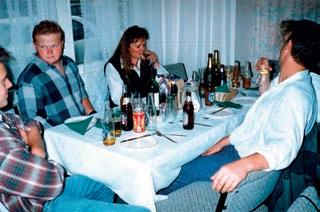
Te ara ki tua Road to success trainees (from left) Liana Manu, Shaun Tomai and Betty Heremaia Sola
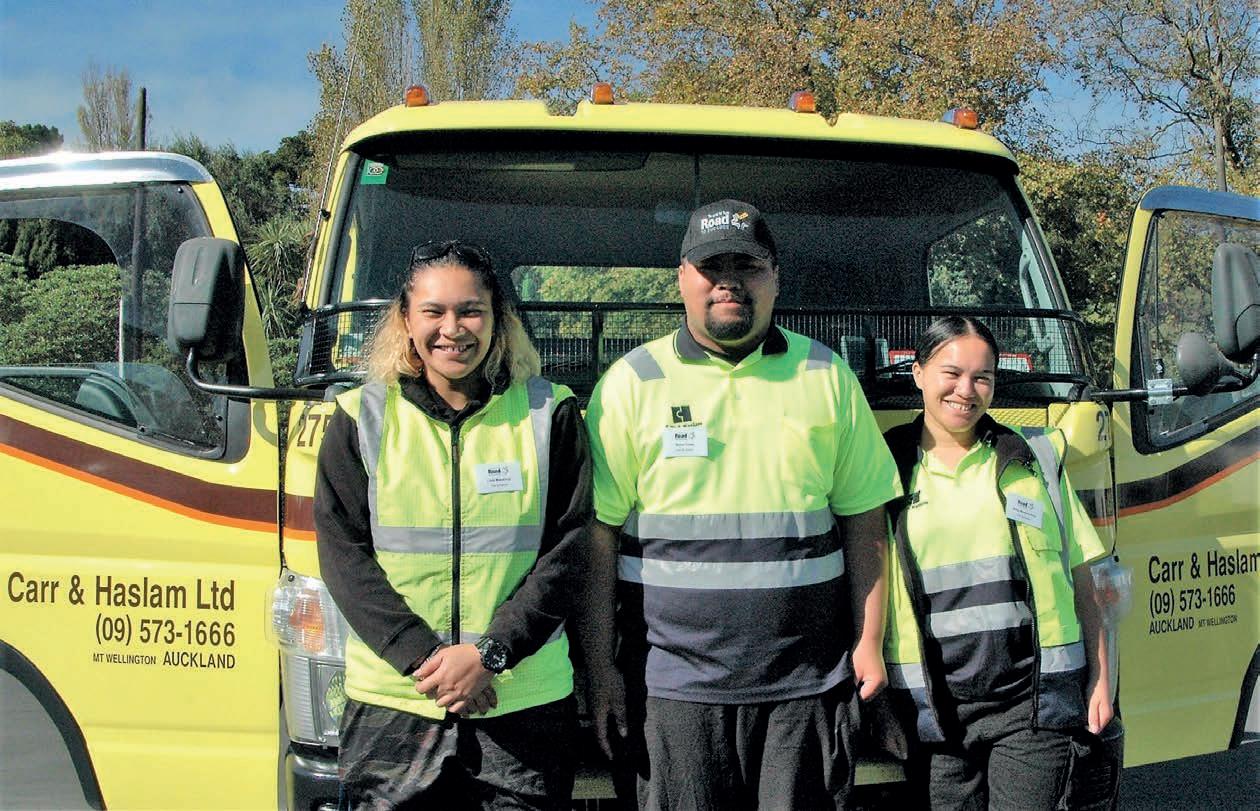
They’ve built it...for you
to get behind it Story Wayne Munro
IT’S A BIT LIKE THAT LINE FROM THAT KEVIN COSTNER
movie Field of Dreams – mangled a bit over the years to: “Build it and they will come.” (In truth, the actual line was: “Build it and he will come,” but never mind: Popular misuse rules).
In this case, it’s a matter of “Create it – and they will get behind it.” Well that’s the critical, much-hoped-for response to the Road Transport Forum’s development of a truck driver traineeship.
And at the late April launch of Te ara ki tua Road to success – held, appropriately enough, in “a little tin shed” at longtime Auckland road transport operator Carr & Haslam’s Mt Wellington base – it looks like a matter of so far, so good.
There’s Government acknowledgment that this is a good idea in the form of Cabinet ministers Michael Wood (Minister of Transport and Workplace Relations and Safety) and Social Development and Employment Minister Carmel Sepuloni, both attending.
There’s a pretty good turnout of transport operators who’ve turned up to show their support, joined by reps from industry associations and plenty of the organisations that have actively helped get the traineeship up and running – as Michael Wood puts it an “alphabet soup list of groups” that includes MITO, MSD (Ministry of Social Development), Waka Kotahi NZTA, MSD’s Kiwi Can Do training programme, the Tertiary Education Commission… and more.
But most of important of all, as everyone – including the two Cabinet Ministers – acknowledges, there are three of New Zealand’s first 11 trainees present: Betty Heremaia Sola – a 21-year-old who’s chosen trucking over teaching…
Plus Liana Manu, a 24-year-old mother of two who just “loves driving.” And Shaun Tomai, 19, who decided he wanted to be a truck driver “because you get to work by yourself – you don’t have to rely on a team.”
Wood tells this trio they are “really the stars of the show…..this day is all about you. And it’s about celebrating the steps that you have taken both for yourselves and also in terms of playing a really critical role in what is an exciting and important industry for our country.”
The reason it’s appropriate that the launch is held here is because these three trainees have all gone to work for Carr & Haslam. And because, as RTF CEO Nick Leggett puts it, the company’s boss, Chris Carr, “is an industry champion like no other.”
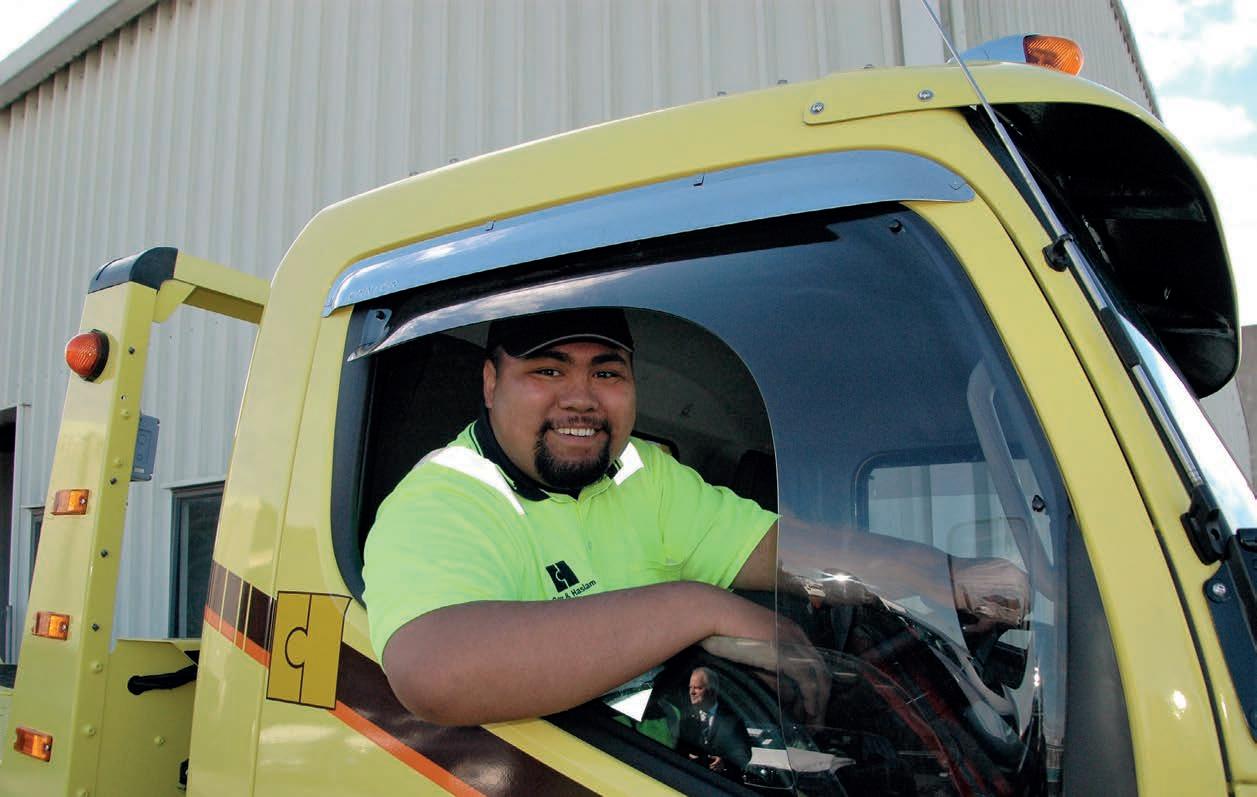
Shaun Tomai is just two weeks into his traineeship, and is itching to get behind the wheel
Leggett explains that Te ara ki tua Road to success is the industry’s response to the driver shortage: “We believe in industry solving its own problems where possible, so we decided the time was right for a dedicated truck driver traineeship, run by the RTF for the industry we represent.
“Trucking has an ageing workforce and we want to bring a new and diverse range of people into the road freight transport industry. We want trainees to be clear on a career path and to be rewarded for their successes.
“We believe that over time, this training will ensure a higherskilled and safer workforce, leading to safer roads.”
The training mixes the practical and the theory and is designed to lead directly to three new NZQA-approved micro-credential qualifications relevant to the industry – completed online and delivered through MITO.
The big thing is that, as Leggett adds, “this traineeship allows people to work and earn money while they go about their training.”
It primarily aims to produce more drivers, but also provides a career path for those who prefer other skilled roles in the industry.
And, yes, it is different to anything that has gone before it, as Leggett explains: “I think there’s often a view that younger people need to change to fit into something – to fit into the workforce, to fit into training.
“And I think what’s different about this programme is we’re taking the opposite view: We recognise that the industry has to change to fit the desires of the modern workforce. And that means qualifications, structure, on-the-job training, licence progression, as we are short of willing Class 5 drivers in this country.
“And the challenge for our industry is that many only have Class 5 vehicles, and so it’s harder to train. But it’s not impossible if we work together.
“So I want to emphasise that this is very much about the industry taking the lead in finding solutions to its own challenges.”
The traineeship has been developed up by the RTF over the past year, with big assistance from Government: The Tertiary Education Commission and MITO “have come to the party in getting the microcredentials available” – and have waived the usual fees until the end of this year.
MSD is placing registered job seekers and others out of work as the result of COVID-19, into the trainee programme, with trucking companies. In fact the three trainees here all came via the MSD’s Kiwi Can Do programme.
Carmel Sepuloni tells the launch that “without this industry and its dedicated workforce, we simply would not have been able to deal with COVID-19 as well as we have. Your workforce deserves a huge thankyou for your efforts.
“But we also know you are a workforce struggling with a shortage of labour. The Road Transport Forum conducted research in 2020 directly with road freight transport operators and 35% of respondents identified a shortage of drivers being a problem for their business. At that time 53% had a shortage of drivers in the past three years.
“This partnership won’t immediately fix this issue, but if it is successful – which I have no doubt it will be – it will provide a blueprint for us to follow. It will also provide another pathway for people who are on a Job Seeker support benefit to move into a longterm and fulfilling career.”
The traineeship sees an industry partnership between road transport and MSD – with the industry “able to provide a job opportunity for that young person who is now work ready,” she says.
“And that’s what we want to see more of…..making sure that there are pathways for our young people.”
Leggett agrees that “this is about developing careers…. The truth
is that 96% of drivers are men. The median age of truck drivers is 54. And 40% of drivers have no formal qualifications. And those are things that over time we can overcome.”
Wood too focuses on the industry’s “ongoing challenge of making sure that we do have a workforce that is fit to meet our needs, not just now, but in the future.
“The work that RTF and others have done has revealed that we’re going to have to do some work and get innovative if we want to meet that need. And also if we want to have a workforce that looks and feels more like the NZers that we serve…”
He reaffirms something Sepuloni has said – that the collaboration between Government departments and industry to address problems is, “one of the things that we love in Government and we’re constantly trying to do better…
“And the reason that you’ve got two of us from Cabinet here today is because that’s what we’re seeing happening, in a very real and very impactful way, through this project.
“We’re solving multiple problems. We’re dealing with those longterm workforce needs. We’re dealing with our shared ambition to diversify the workforce. We’re dealing with the fact that we know in NZ that we do have too many of our young people who fall out of the system and who don’t get into careers that can take them places, give them stable incomes, a sense of wellbeing and purpose.
“And through bringing together our organisations – through having a shared strategy and a common purpose here – we’re solving multiple problems there. So I think this is a real breakthrough…”
Wood acknowledges Carr & Haslam “for stepping forward, bringing trainees into your organisation. No doubt there is some cost involved at the outset, but I’m absolutely confident that this going to be a great longterm investment for you.”
And he lays down the challenge “to others, to come forward as well. Because when we work together, we can get really great outcomes, both for the sector and for the young people of our country.
“When we get an initiative like this set up, and we get a structure and a framework in place, we need people to come forward and take it up.”
Carr confirms that “yes, there is some cost” in taking on the trainees, and adds: “But how much would the cost be if we didn’t do it?”
Insurance Solutions –from Owner Drivers to Large Fleets
With extensive heavy transport and forestry insurance broking experience offering more than 50 years combined industry knowledge, Di Watts & Kim Oettli are providing independent and expert advice to ensure you are well covered. Let us help you keep on trucking!!
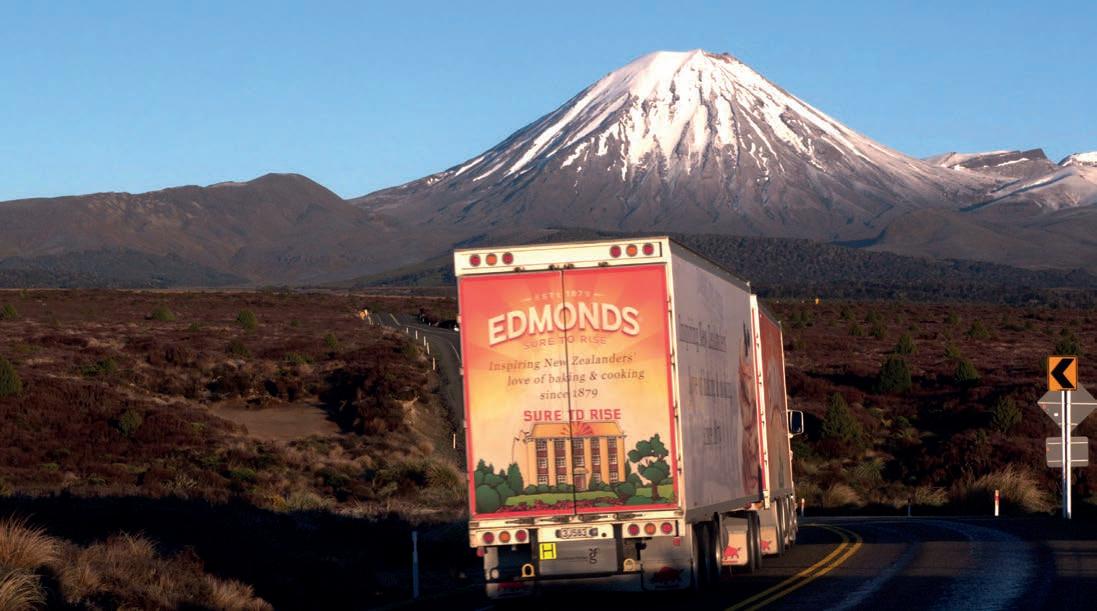
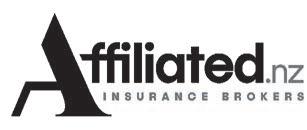
Di Watts Director & Executive Broker m: 027 308 3803 e: di@affiliated.nz Kim Oettli Director & Executive Broker m: 021 611 434 e: kim@affiliated.nz
KEEP ON TRUCKING
TD31606
TD31447
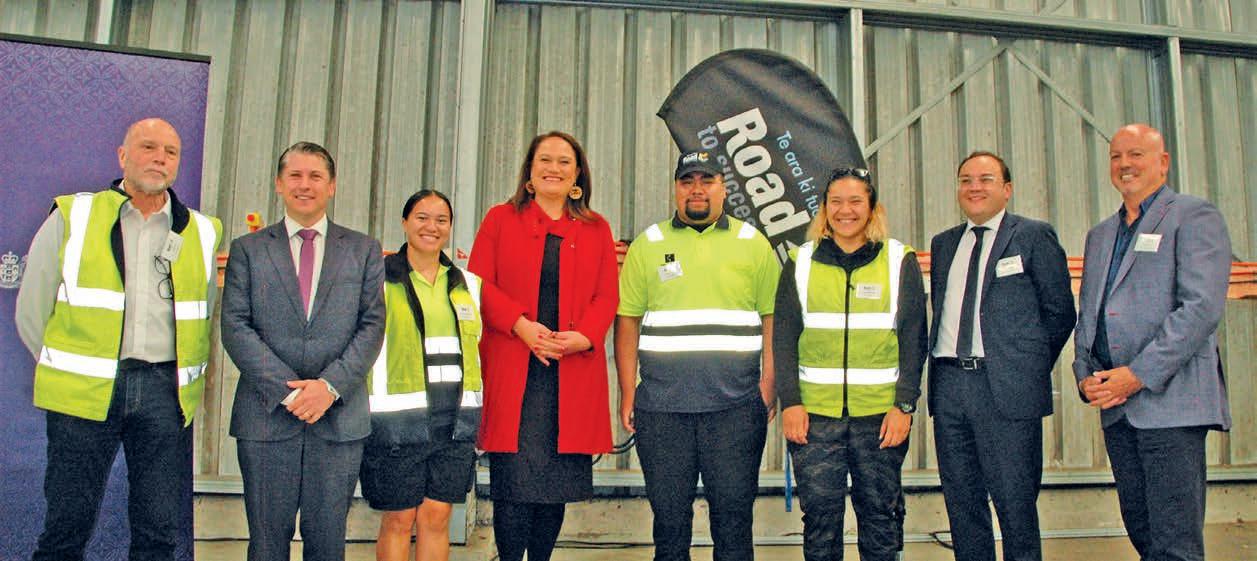
The presence of the two Cabinet Ministers at the launch of Te ara ki tua Road to success is a reflection of the Government’s appreciation in seeing a successful Government/industry collaboration. From left to right are: Traineeship early adopter Chris Carr, Transport Minister Michael Wood, trainee Betty Heremaia Sola, Minister of Social Development and Employment Carmel Sepuloni, trainees Shaun Tomai and Liana Manu, RTF CEO Nick Leggett and RTF chair Greg Pert
In Carr & Haslam’s 159 years in business, it has progressed from horse and cart, to petrol engines, to diesel engines…and will soon have an electric truck. But there’s always been one constant: “Every one of those bits of equipment we’ve had has had a driver in the front of it. That’s going to remain for a long time. And anyone who tells you that autonomous trucks will replace drivers are actually talking through a hole in their what’s-it!”
“The Road to success for us has been great – even in these very, very early days.”
The three drivers arrived “well-prepared to do the job. Not to the standard that we will be asking them to (achieve), but certainly to a standard that any educational facility could prepare them for. So we were dealing with people who knew what they were doing to start with. So that was absolutely great.”
Better still, he says, they came with “a great attitude. You can train people, but you can’t train attitude… The thing with this programme is the mentoring and support that will follow it up. So we can all help them maintain that attitude, while we increase their knowledge in what we do.”
He stresses the importance of the programme’s qualifications: “They will earn and take qualifications away from us that they can take to another job…overseas if they need to. These are qualifications that will remain with them permanently.”
Carr closes with this: “Just remember – a moving truck is a moving economy.”
He thanks the RTF and MSD “for getting this programme established….and I challenge my fellow operators to get off their arses!” and support it.
Liana Manu had worked at CourierPost as a freight handler, before becoming a Mum. Now, with her son four and her daughter three, she wanted to get back to work – and, since she “loves” driving, was encouraged by her Dad to try truck-driving.
ANY SHAPE, SIZE OR COLOUR WE REPAIR AND PAINT THEM ALL
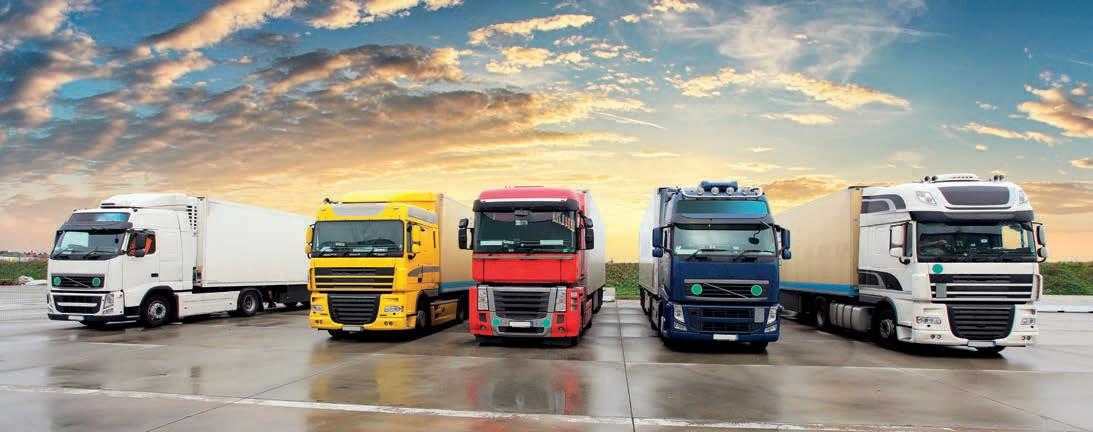
Ph. 09 634 4333
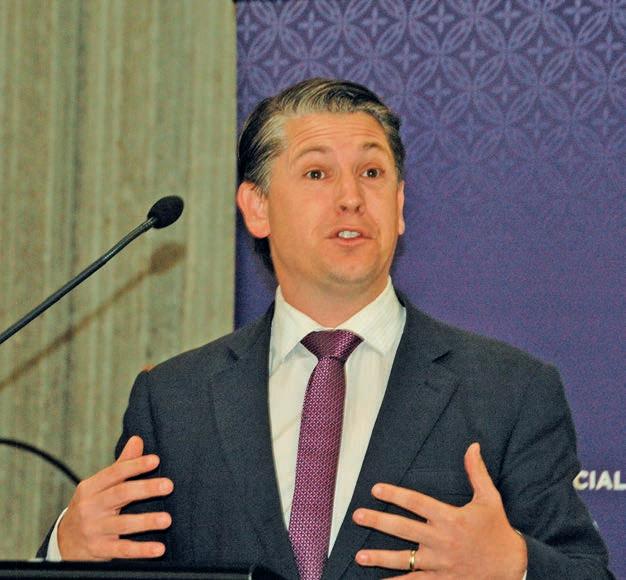

All pictures, from left to right: Michael Wood calls on more transport operators to become involved in the traineeships....Carmel Sepuloni says she “loves” seeing Government/industry collaborations like this....trainee Betty Heremaia Sola and her current truck
“I have had my full (car) licence for a while. And then when I found that you could do truck driving, I jumped on truck driving.”
Through MSD’s Kiwi Can Do she was supported to successfully study for and gain her Class 2 truck licence – and soon after (in March) was directed into her traineeship at Carr & Haslam.
She’s driving a Class 2 4x2, doing pallet deliveries around Auckland, overseen by a trainer.
What’s the truck? “It is….I have no clue,” she giggles, and adds: “It’s a manual though – eight-speed.
“I love it – love every moment of it. I love going to work. I think it’s about being able to be out and on the roads and that’s just….it’s amazing!”
And yes, she eventually wants to do “long-distance driving. I’m aiming to go all the way up to Class 5 – drive trucks and trailers.” Under the Road to success traineeship, she should achieve that after one year.
The people at Carr & Haslam, she says, are “really supportive. They’re not pushing me to do things that I can’t do.”
And the theory part of the traineeship? “It’s alright. It’s good actually….really easy to manage. It’s not too hard.”
Fellow-trainee Betty Heremaia Sola had tried a few different career possibilities before this. Initially she studied Te Reo Maori, “then I started a teaching degree, because I thought I wanted to be a teacher.”
But after one semester “I said no, I don’t want to carry this on. Maybe later – I don’t know. I want to go out and explore the world first….explore the workforce, and what career paths are out there before I commit to that.”
Last year she worked (in a paid internship) as a park ranger for Auckland City.
But then, “I just….I don’t know: I wanted to upscale my licence and see what opportunities would arise through that.”
It is, she says, “really good” that MSD’s Kiwi Can Do programme led to her getting her Class 2 licence…and then, in February this job.
After about a month in the yard, she went to work as a driver – on the car transporting work which is one of Carr & Haslam’s specialties. She drives a small 4x2 single-car unit, picking up and delivering cars all around Auckland.
“It’s been good….really enjoyable. It’s different to what I’ve done before. I didn’t really have a big interest in cars, but since working here, I don’t know….I’m like, ‘oh my gosh, that’s a BMW!”
Not that handling expensive cars fazes her at all – nor does manoeuvring the truck in tricky spaces: “There are really tight places that I need to park in or turn around in. And a lot of like cars surrounding me too – but I just take my time usually.”
Shaun Tomai came to Road to success after first working in the warehouse at Owens, picking and packing, then trying his hand as a house painter. That ended badly: “I left because the boss ripped us off.”
He had an idea – “to do something along the lines of driving and deliveries.” So he joined the Kiwi Can Do programme, got his Class 2 licence through that…and this traineeship as well.
Just two weeks into it, he’s in the yard and the store – learning about the tricks of driving the different cars: “Like there’s all brands of cars and some of them are hard to drive. Like you know, using the handbrakes and the mirrors.
“Because when you get to pick up the cars, you need to know where everything is. You could be picking up cars like Porsches and McLarens or something. So you’ve got to be real careful about the things you do.”
“So far,” he says, “the job is real good.” He appreciates the traineeship: “All these places around, like they don’t really offer you experience eh like what we’re doing here.
“This is a real good foot in the door. See, like driving Class 2, Class 4, Class 5. Yeah, it’s really good, it helps people. Young people like me and all the other cadets around.”
His family, he says, is right behind him: “They’re telling me that I should go for it, because in the future I want to try and become a contractor. Get my Class 5…have my own truck.”
Seeing the country is one thing that attracted him to truck driving: “Well…I haven’t been out of Auckland. Or, like I only go up North – but that’s all. So, I’d like to maybe get to explore Auckland and NZ while driving trucks.
“And plus I like working by myself, because you don’t have to rely on a team. Especially when you’ve got to pick up the slack for them.”
Nick Leggett says that Road to success “is going to be measured by how sustainable it is. So is it still alive in five, 10 years’ time?
“But the biggest, most important measure is: Are road transport businesses going to take the philosophy into their hiring, into their
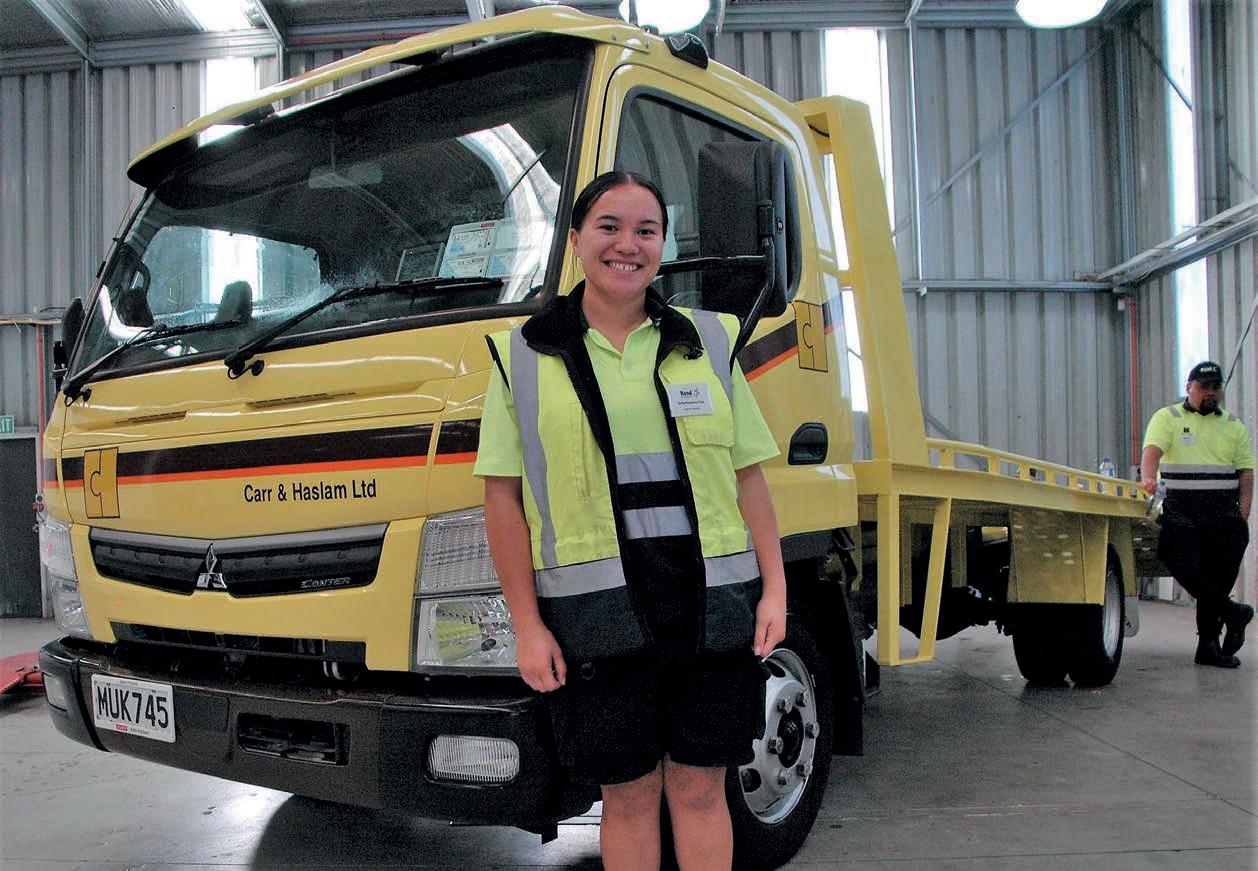
investments in staff pay, welfare, qualifications, training. That’s going to be where the change is.
“So we can stand here and place people into businesses and make it work, but it’s a reorientation of the industry – thinking, instead of just grabbing a Class 5 driver from somewhere, ‘we might have to create some of them. And we might have to work with our neighbour to create some of them.’ And that’s what this is about.
“So it’s about a new philosophy and it’s about recognising that people who are looking to work today need a career path and they need a structure. And we’ve stood that up. And now we’ve got to see it lived through the industry.
“We’ve had really good feedback. The point is that it is working. There are people in training in different parts of the country. And some of them employers have found themselves and they’ve just signed them on as trainees and they’re doing the qualifications and the programme. Some of them, (programme co-ordinator) Fiona (McDonagh) has placed.”
Yes, some transport operators already “do really well in this space – but this could be an added advantage. And, of course, we’ve got the micro-credentials, which are really an important component.”
McDonagh says that most of the 11 trainees so far placed around the country have started work fresh from getting their Class 2 licences.
Won’t the fact that many operators don’t have Class 2 trucks pose a stumbling block for them? Well actually, Leggett says, “some operators have either purchased a smaller (Class 2) vehicle or are looking to do that…
“It is amazing, the amount of operators that have gone... ‘Well, actually, we’ve got all these vehicle classes and we’re not graduating people through them.’ And this programme can assist them to do that.
“The message, I suppose, is that – well, trucking operators know – good Class 5 drivers don’t grow on trees. We’ve got to grow them.”
The traineeship programme provides companies with the tools: “A lot of companies don’t have these tools because they’re small businesses, medium businesses. And so it’s the micro-credentials, it’s the licensing progression, it’s the support from Fiona…
“And it’s the training structure and, of course, actually finding the recruits.” To which McDonagh agrees: “Finding the recruits. It’s the introduction to some new people, rather than using the same techniques and the same things.”
Leggett and McDonagh believe that the launch of Road to success is the start of a movement, as he says: “Some people will join the movement. Some people have joined. Some people will join in the next year. Other people…won’t join at all. That’s fine. We need probably 5% of road transport operators to take part in this and we will make a tangible difference to the supply of Class 5 drivers.”
And that, he and McDonagh believe, is “100%” a realistic target.
This year, says Leggett: “Our target’s to get it up and running and get some people graduated. As I say, we could be target-driven fruitcakes and put all our efforts into signing people up to bolster the numbers. Or we can build something sustainable….
“We’re taking time. Fiona’s doing a great job at building the kind of business processes and assistance and fleshing out the structure. So operators have got some good, tangible resources. And that’s what we’re spending our time doing.
“If in a year’s time, we could have 50 people going through, I think we’d say that’s a success.”
McDonagh: “It’s being able to see Betty, Shaun and Liana at a graduation in 12 months’ time – still passionate, still engaged, still motivated and supported. That’s what we’re aiming for.” T&D







